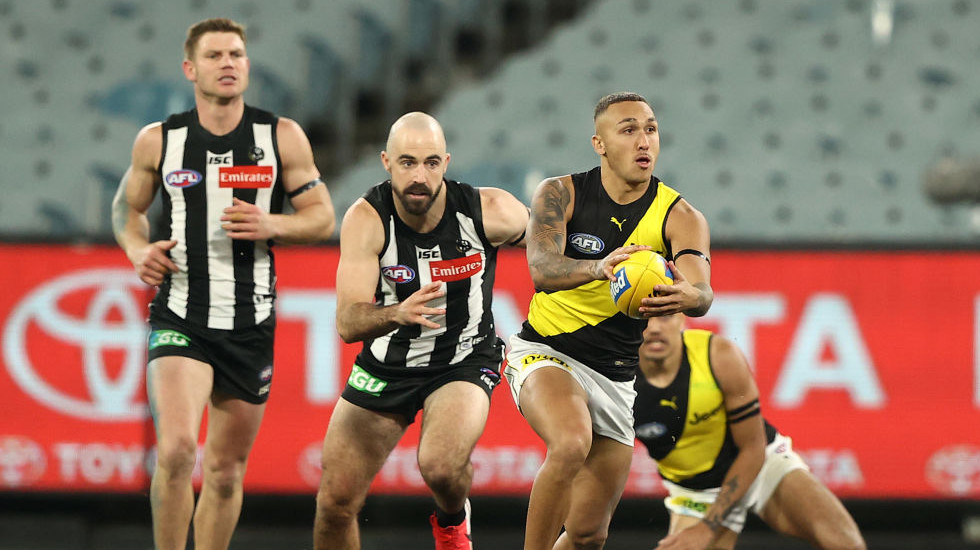Last week’s Collingwood-Richmond game produced just two goals in an entire half of football. Photo: GETTY IMAGES
Even before the conclusion of AFL Round Two, the usual suspects were manning the PR barricades, grimly defending the quality of footy fare which – you guessed it – largely involved grim defence.
After an unprecedented delay and then anticipation around the restart, the letdown was sadly predictable; arm wrestles, wayward skills, grinding congestion, low scoring and the inevitable couple of blow outs.
This columnist’s response is: what else did you expect? The game has doggedly tracked this way for the past two decades. Indeed, there is a school of thought that suggests we need to, on the whole, substantially re-frame our expectations about what footy at AFL level will deliver in terms of spectacle.
Let’s pick this apart. Scoring rates do not necessarily make or break the aesthetics, but in the first quarter against Collingwood, the reigning premier Richmond, which kicked 47 goals in three finals last year, managed one point. In the second half, the Magpies scored three behinds.
Against the Dees, the hapless Blues couldn’t even score in the opening stanza, while their opponents kicked a solitary goal in the second half – and still won. Up at the Sydney Showground, home team GWS and its opposition North Melbourne were locked on 18 points apiece at half-time, totals which would not be out of place in the NRL.
Given teams are scoring four goals less per game on average than 25 years ago, this should not surprise. Heading into the Lions and Fremantle clash, barely six players across the sides averaged a goal per game. The scoring picture is even gloomier at Melbourne; aside from new recruit Harley Bennell, not a single player who ran out against Carlton averaged more than a goal per game.
But you can choose your own metric to demonstrate how the spectacle has declined. Since season 2000, handballs are up nearly 50 per cent, tackles per game have doubled, contested marks have dropped by 20 per cent, and marks inside 50 even more.
It’s not just direct physical pressure, either. The so-called “inferred pressure” is taking its toll, too, with unforced errors up almost 70 per cent. Oddly, although teams on average score about one-fifth less than 20 years ago, the competition’s average winning margin has not altered much.
End result? A numbing hybrid of rugby’s ruck and maul and soccer’s keepings off. All the pressure and tackling in the world cannot compensate for the ability to score. Or take high marks. Or compete one-on-one. Or move the ball with freedom.
But the usual suspects, who privately concede their concerns for the AFL product, went public with excuses around dewy conditions, shortened quarters and the long layoff. Knowingly or otherwise, they were missing the point.
“Clearly defence is ahead of offence at the moment,” now-Fremantle coach Justin Longmuir told me at the back end of last year. “No team in their right mind would allow 80 per cent of the forward entries to be directed towards one player, allow it to be one-on-one and give them space to operate. That won’t happen.”
Tackling data is particularly revealing. A sample of three rounds – Round 2, 1995, Round 2, 2005 and Round 2, 2020 – shows that the points scored to tackles ratio has decreased from 3.13 to 2.03 to only 1.31 last weekend.
Add the calculated team defence, maniacal pressure on the ball carrier and shifting defensive structures, according to play up the field, and it’s easy to see why the game at the top level has reached stalemate.
“It’s a time and space thing,” said David Parkin, noted premiership captain and coach. “I don’t know what the answers are. At least with scoring there is some kind of impetus in terms of joy for people watching. But 95 per cent of the players are in 25 per cent of the ground.”
But here’s the push back from the industry. According to Longmuir: “I understand how higher scoring is more enjoyable for supporters, but my counter action is, would a supporter prefer their team plays free-flowing footy and let their opposition score at will, and possibly lose by 10 goals, or for your team to defend and be in every game?”
And there’s the rub. Style versus substance. A nostalgic sense of beautiful chaos that once characterised the game headbutts the grim reality of defensive strategies designed by a phalanx of coaches and analysts.
The former sentiment compels fans to seek out glories from previous eras on YouTube, but the latter is the here and now. Deal with it or reframe your own expectations around what watching AFL footy means.
Again the question is raised, not without empathy: what else did you expect?












Ardenopolous Street was a great amateur player of the mid 1990’s. He also worked as a grill man at my local cafe but his fiery disposition wasn’t appreciated by his pale faced boss. I wonder if the first poster is the same cat?
You know for me local/country footy is so much more enjoyable than today’s AFL. Although the standard is inferior it resembles the way the game at the top level used to be. Players in positions, plenty of good contests, free scoring and umpires in the back ground. You can also have a conversation with the person next you – unlike attending a game of AFL where you get blasted with irritating garbage from some clown with a Public Address system.
Mr A Street (Glen Iris)
Dear Elliot,
Thanks for your column, I thoroughly enjoyed it. Your comment of ‘a hybrid between rugby mauls and soccer keepings off’ is spot on. One team has possession, pressure pressure scrappy scrappy handball handball tackle tackle then the ball finally gets a kick. Mark, then switch play ‘backwards’ to the other side. Chip, chip, chip then long kick down the boundary to a contest, which no one can mark then out of bounds. Repeat.
Every game.
In the 90s they openly said the game is now entertainment when it went to Friday night footy. It simply is not entertaining. I now choose ‘Escape to the country’.
When the pies and tigers were all drawn up with 2 minutes to go, I was bored. Why?
Sad. My love for the game is now local footy.
Full forwards play at full forward.
CHF play at CHF and so on. 2 umpires.
My thoughts are because they are less fit and have to stay home in position. Makes for a far greater spectacle.
In AFL they are all super athletes, which makes a poor spectacle.
Keep writing mate.
Patrick Haseler
You won’t change the current defensive game style until you breakdown 18 man team defence.
IT ONLY BREAKS DOWN WHEN PLAYERS ARE MISSING FROM THE STRUCTURE.
This is when coaches go nuts .
This is why Clarkson,Lyon, Scott, and Matthews all said we need to reduce numbers.
The only way to achieve this on a permanent basis is REDUCED PLAYERS ON THE GROUND.
It’s simple.
Of the old 18 positions only the ruckman still exists!
We have to let go of a little of the past to gain a lot of the past !
Jeff Mornington